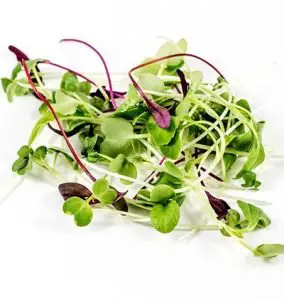Growing healthy microgreens frequently prompts people with questions such as “What are cotyledons?” and “What are true leaves on microgreens?”
Microgreen seed vendors and authors often forget to explain terms before using uncommon terms when describing the potential of the sprouting process of flavorful microgreens. For instance, we say “Harvest during the cotyledon stage” and “wait until the first leaves form before harvesting the microgreens.”
Doing this only confuses people just starting with fresh microgreens, making what is a very simple task seem more complicated or technical than it is, and lowering the chances that they will try growing their microgreens in a soil medium or seed raising mix.
This article aims to make growing these baby greens as easy and enjoyable as possible. We hope that this article on cotyledons will help those who are new to microgreens by explaining the terminology. We want to make the growing of microgreens easy for you and make sure you have trays of microgreens ready to harvest every day. Reaping the wonderful benefits of the intense flavor, essential nutrient content, vitamins, and minerals they have compared to mature vegetables or full-grown vegetables.
True Leaves: What Are They?
 All the nutrients in the crop seed begin to be used to start growing the stem, roots, and the first microgreen leaves. When the roots start to grow downward, the leaves begin to unfurl. The energy for this growth and movement will come from the cotyledons, which also receive the same energy from the endosperm.
All the nutrients in the crop seed begin to be used to start growing the stem, roots, and the first microgreen leaves. When the roots start to grow downward, the leaves begin to unfurl. The energy for this growth and movement will come from the cotyledons, which also receive the same energy from the endosperm.
First true leaves have vascular structures and frilly edges, so they are downsized versions of the larger mature plant leaves. Not all first true leaves have frilly edges, though, like the mustard leaf. But they will look more like mature plant counterparts.
Cotyledons: Monocots or Dicots
One seed can only be classified as a monocot, or it can have two cotyledons and thus be classed as a dicot. We use onions and leeks as microgreens, which are usually dicots, and cotyledons do not emerge from the soil.
Cotyledons are made up of smooth, flat surfaces in simple shapes, such as ovals or heart-shaped in a mustard plant. A typical cotyledon looks heart-shaped in shape with smooth edges. Although the foliage tends to be more vascular, lobed, and frilled on its edges in the first year.
Our goal with this article about cotyledons isn’t to teach you how to grow them, but to help you produce the healthiest, most flavorful mini – vegetables possible.
Does Photosynthesis Occur On Cotyledons?
Those first true leaves are undoubtedly the source of the plant’s energy source, through photosynthesis. However, it is still uncertain to what extent cotyledons can photosynthesize. Yet, a study by Zhang et al. (2010) indicates that photosynthesis does increase the energy a plant gives off through cotyledons.
In our view, the higher the chlorophyll content, the greater the nutrition imparted to various types of microgreens. We conclude that the cotyledons of many microgreen plants do produce chlorophyll and contribute to the nutrition of microgreens. The reason we believe that is the fast growth rate of microgreens. We reason that many plants do produce chlorophyll under direct light in preceding leaves.
Most likely, plants that do not carry out photosynthesis, like tomatoes, whose cotyledons shrivel and fall off before their true leaves emerge, do not carry out photosynthesis.
Best Time To Harvest
This depends on microgreen varieties. For example, you harvest broccoli, kohlrabi, turnips, radishes, and more microgreens before they form true leaves. Some microgreens, such as mustard microgreens, also should be harvested when they begin to form their seed leaves. The cotyledon leaves are still edible since you harvest them while they are still young.
Their tender, savory stems and leaves come out wonderfully when harvested so early in their growth cycle, and add a layer of flavor in salads, sandwiches, or on top of desserts.
The Flavor
We wait to harvest some microgreens because they have more flavor once they have their first true leaves. When the true leaves form, the flavor will be more intense as well as the concentrations of vitamins. The majority of microgreens we grow are harvested in the cotyledon stage, including broccoli microgreens, cabbage microgreens, kohlrabi, radishes, sunflowers, etc.
Most herb microgreens, like basil, cilantro, and parsley, are harvested after the second true leaf forms. However, some leafy vegetable microgreens, like mustard and celery, are harvested right away.
On the other hand, the true leaves also taste bitter, so these infant plants are best harvested during the cotyledon stage. The concentration of nutrients decreases as the plant ages, so it’s good to harvest at that stage.
Confused About When To Harvest What?
We realize it’s not clear, so we plan to publish an article very soon discussing when to harvest microgreens before or after the true leaf stage. When that article is published, we’ll post a link here. Or, you can subscribe to our weekly email newsletter for more growing tips and links to the latest articles.

